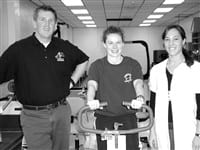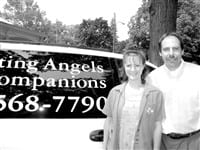It’s All Working Out Applied Exercise Science Majors Cultivate A New Career Field In Health And Wellness
There is a new professional force gaining strength across the country, ready to welcome the corporate climbers and entrepreneurial minds of tomorrow.
In this branch of business, though, the CEOs wear gym shorts.
As the booming industry of health and wellness continues to grow, the career paths of one group of specialists are multiplying: those well versed in applied exercise science and related fields.
Mark Blegen, Ph.D., co-director of the undergraduate program in applied exercise science at Springfield College, a national front-runner in career preparation within exercise science, said he sees an increasing number of students enrolling at the college with the express intent of working within the discipline, and in turn more and more upperclassmen are setting their sights on unique jobs and graduate work to prepare for positions within a developing field.
Gone are the days when exercise science majors were relegated to jobs at a gym or a local YMCA, he said. Those jobs are still attractive and available to many exercise science majors, but now, graduates are also securing specialized, often high-paying jobs in corporate settings, hospitals, health and wellness centers, and insurance companies. Or, they’re capitalizing on the growing entrepreneurial opportunities the field offers them, opening their own gyms and health-based businesses and serving as external consultants.
Blegen said that due in large part to a greater awareness of the importance of good health in all facets of life in recent years, exercise science is one of the fastest-growing professional fields in America today.
“Our society needs people that know and understand exercise,” he said. “They are an excellent addition to the health care industry, and the demand for these people is growing everywhere because of the changing attitudes toward the importance of exercise as a major part of health and wellness.”
“We are starting to see companies, and to some extent, entire states take a more proactive view of health,” he continued. “They are creating environments that treat wellness as important parts of a whole.”
Joint Ventures
Lori Martin, a first-year graduate student with a bachelor’s degree in kinesiology, added that there are plenty of job openings for exercise science majors. Martin worked in the field for two years before deciding to work toward her master’s. She worked as a corporate fitness specialist for General Electric, helping a variety of populations, from management to factory workers, maintain healthy, safe work habits.
“We catered classes around shifts and did a lot of wellness promotion,” she said. “The idea was to get people moving, and active. I had a great experience.”
At the time she secured her position at GE, shortly after graduating from college, Martin said she saw several opportunities within exercise science. Now, she sees even more, and added that part of the reason she decided to return to school was to give herself a challenge and stay on top of a fast-changing market.
“In this field, you are constantly learning new things,” she said. “At the same time, people are constantly learning what types of exercise and wellness services are available to them, and that creates new opportunities for us.”
At Springfield College, undergraduate students majoring in applied exercise science study physiology, exercise prescription for normal and special populations, measurement, nutrition, and management skills. Blegen said the degree prepares graduates for entry-level jobs in fitness and health and wellness, as well as jobs in related industries, such as pharmaceutical sales (“because they understand the science of the drugs,” he said) and the insurance field (“because they have an excellent understanding of risk factors.”)
The college’s graduate program, which is sectioned into two concentrations – exercise science and health and athletic training – further prepares students for jobs in clinical, administrative, rehabilitative, corporate, and academic settings. As the field continues to change, Blegen said the college’s attention to different trends within exercise science shifts as well.
“We always look at the different positions that are surfacing and look at what seems to be growing. We are working on strengthening our collaborations with area businesses in order to develop strong relationships and connections. I think there is plenty of room for people in this field to grow locally, so we concentrate on creating a synergy within the community.”
Flexible Hours
Perhaps the greatest strength of the discipline, however, is its pliability; students pursuing a future in exercise science, Blegen said, can really write their own meal ticket, or at least their own job description.
Spring Silverman, a senior at Springfield College, nodded in enthusiastic agreement with Blegen’s words. On the cusp of starting her own career, Silverman has aspirations of creating a niche for herself working with children, addressing the immediate problem of childhood obesity.
“I love kids, and I love that I can use what I’m learning to work with them in a way that is really important,” she said. “It’s so true that you don’t have to work in a ‘Y’ with this degree, or do any one thing. Whatever you want to do, you can do it, and you can be really successful at it.”
Silverman didn’t start out at Springfield College in applied exercise science, but early on completed a research project on the subject, and soon switched her major. “I didn’t realize how much you could actually do with this degree until I finished that paper,” she said. “There are some real entrepreneurial opportunities.”
Blegen said some of the most prevalent careers within the field, in fact, are creative endeavors that address pressing issues facing society, including child obesity.
“People are realizing that it is more and more important to get kids addicted to exercise early on,” he said, “So more people are investing in fitness for their children, and for themselves. They are seeing the obesity rates in America, they are seeing that obviously, something is wrong, and it needs to change.”
That’s where students like Silverman and Martin come in, Blegen continued. They are formally educated on how to initiate lifestyle changes – big business across the country – and can address much of the confusion many people have regarding exercise and nutrition.
“A physician might tell a patient that they need to exercise, but once that person gets to the gym, they might not know what to do,” he said. “Right now, people in exercise science are positioned to take the entire field to a whole new level. Whatever they want to do, they can do it; if the position doesn’t exist, they can create it.”
Some of those endeavors include personal training facilities for adults and children, or consulting businesses for companies, schools, and other organizations looking to revamp their health and wellness programming.
Others still are positions within larger organizations that may have never existed before, but are created to accommodate the talents of exercise science experts.
“Hospital-based health and wellness centers are a great opportunity for our students, in part because they tend to operate in the black, so of course the health care facilities want to focus on them.”
No Bones About It
In short, Blegen said exercise science is becoming a unique discipline in that students are entering the field in large part because they can create their own destiny.
“This is becoming a program that is taking students beyond the traditional thinking of what a career is,” he said, motioning to the two students poised to capitalize on that very notion. “One day, I’ll visit Spring and Lori at the businesses they own, and I’ll see success firsthand.”



Comments are closed.